Meissen and the Commedia dell ‘arte as a subject for a news letter was suggested to me by an American friend and collector. I hope that he and you will find it informative.
The theatre of the Commedia dell'arte flourished in Italy during the sixteenth, seventeenth and eighteenth centuries although its roots go back even further. The performances were given by professional actors who travelled in toups throughout Italy performing on temporary stages in the city streets but also in the palaces of the nobility. Some of the troups became famous outside Italy and performed before the royal courts of Europe.
The theme of the plays involved disgraceful love intrigues, clever tricks to amass a fortune or outwit some simpleton, plotting maids, bragging captains, aged fathers and wily widows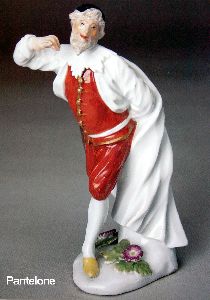 . By the end of the sixteenth century a set of stock characters had been established, each with movements and gestures that represented his or her personality. They wore costumes that helped emphasize their . By the end of the sixteenth century a set of stock characters had been established, each with movements and gestures that represented his or her personality. They wore costumes that helped emphasize their  characters and which enabled audiences to recognize and anticipate the behavior of the actors. Pantelone wore red fitted knee breeches, a black robe and a mask with a long beard. Pulcinella was a hunchback, dressed in a white simple poor costume with a sugar loaf hat (coppolone). The unique talent of the Comemedia players was to be able to improvise comedy around a pre-established scenario and to respond to each other and the audience. The actors also made use of the 'lazzi', specially rehearsed routines that could be inserted into the plays at convenient points to heighten the comedy. Performances of the Commedia dell'arte were recorded at the Dresden court of Augustus the Strong in 1709 and 1719 and a troupe of Commedia actors was resident at the Dresden and Warsaw courts from 1738, giving regular performances. The first Commedia figures produced at Meissen were modelled in brown stone ware (Böttgersteinzeug). characters and which enabled audiences to recognize and anticipate the behavior of the actors. Pantelone wore red fitted knee breeches, a black robe and a mask with a long beard. Pulcinella was a hunchback, dressed in a white simple poor costume with a sugar loaf hat (coppolone). The unique talent of the Comemedia players was to be able to improvise comedy around a pre-established scenario and to respond to each other and the audience. The actors also made use of the 'lazzi', specially rehearsed routines that could be inserted into the plays at convenient points to heighten the comedy. Performances of the Commedia dell'arte were recorded at the Dresden court of Augustus the Strong in 1709 and 1719 and a troupe of Commedia actors was resident at the Dresden and Warsaw courts from 1738, giving regular performances. The first Commedia figures produced at Meissen were modelled in brown stone ware (Böttgersteinzeug). 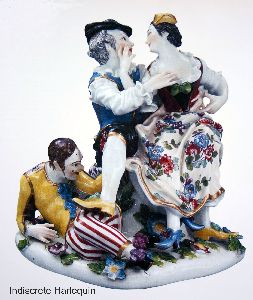 Pantelone, Capitano, Harlequin and Pulcinella amongst others were crated in this medium c.1710/12. However the golden period for the creation of Commedia dell'arte models at Pantelone, Capitano, Harlequin and Pulcinella amongst others were crated in this medium c.1710/12. However the golden period for the creation of Commedia dell'arte models at 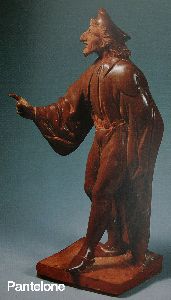 Meissen was between 1735 and 1750 when the modeller J.J.Kaendler (1706-1775) was in his prime. Kaendler's figures of the Commedia dell'arte actors, with their exaggerated gestures and dramatic facial expressions, show his mastery of the medium of porcelain and his ability to impart movement to his subjects. A good example is the Indiscrete Harlequin modelled by Kaendler in 1742. Meissen was between 1735 and 1750 when the modeller J.J.Kaendler (1706-1775) was in his prime. Kaendler's figures of the Commedia dell'arte actors, with their exaggerated gestures and dramatic facial expressions, show his mastery of the medium of porcelain and his ability to impart movement to his subjects. A good example is the Indiscrete Harlequin modelled by Kaendler in 1742.
As well as drawing inspiration from live performances of the Commedia dell'arte at court the modellers at Meissen were influenced by the engravings of such artists as Jacques Callot (1592-1635), Jean-Antoine Watteau (1684-1721), Claude Gillot (1673-1722) and Francois Joullain (1662-1753).
Besides the many single figures and groups inspired by the Commedia dell'arte there were three series of Commedia figures manufactured at Meissen during the eighteen century. The first and most important was the series of eighteen figures created for Johann Adolf II, Duke of Sachsen-Weissenfels (1685-1746) by Peter Reinicke (1711-1768) with the help of Kaendler. I will explore this series in greater detail later. The second series of twelve pairs of children dressed as characters from the Commedia dell'arte was created by Kaendler in 1765 for a commission by Count von Kayserling. The success of the Commedia figures commercially is exemplified by the creation of a third series of fourteen figures by Kaendler between 1771-1775. These figures reflect the influence of the neo-classical and are all on square bases with the model numbers D 40 - D 43.
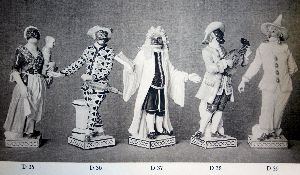
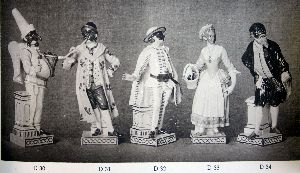 - -
Of the eighteen figures in the Duke of Weissenfels series most were created in 1744, only the female dancing Harlequine is recorded as being made in 1747. Ten of the characters are based on the engravings by Francois Joullain in Louis Riccoboni's Histoire du Theatre Italien published in Paris in 1728. Others can be traced to sources such as J.Callot, C.Giott and A.J.Watteau. At this point I thought it would be interesting to list the players from this series with their model numbers and a short resume of their attributes and background. ( Thirteen of the figures are illustrated below).
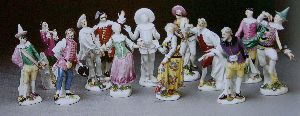
Harlequin Ancien. Model no. 577
Source: Engraving by F.Joullain
Harlequin Moderne. Model no. 538
Source: Engraving by F.Joullain
Harlequin Dancing. Model no. 454
Source: Not known
Harlequin is a comic servant who cannot read or write. He has left his native Bergamo to seek his fortune in Venice as it grows rich from its commerce with the orient. He is an acrobat and a clown and carries a baton or slapstick which he uses to hit the other characters. He is in love with Columbina. His costume with its lozenge pattern of red, green blue and yellow diamonds was an evolution of a mixture of clothes th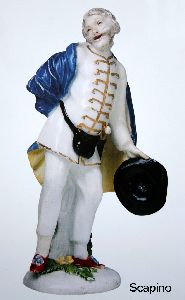 at were representative of his poor standing. at were representative of his poor standing.
Scapino. Model no 392
Source: Engraving by F.Joullain
Scapino also from Bergamo is a money grabbing villain and friend of Harlequin. He is a self made man who is comfortably well off and likes to dress well to impress the ladies. His costume is well made with an elaborately buttoned tunic and long trousers. A money pouch around his waist attests to his wealth.
Il Capitano. Model no. 1063
Source: Engraving by F.Joullain
Il Capitano is a braggart, bold and swaggering, he struts around in a spendid uniform, pursues the ladies but underneath the swagger he is a coward. His costume is a tricorn hat, fine waistcoat and a knee length jacket with 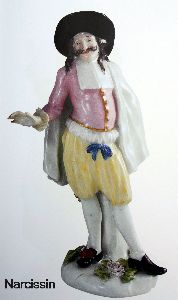 the hilt of his sword protruding from under the jacket. the hilt of his sword protruding from under the jacket.
Narcissin de Malalbergo. Model no. 576
Source: Engraving by Joullain
Narcissin is a friend of Harlequin's. He is roguish and sophisticated, a cowardly villain who would do anything for money. He is cunning, witty and often course, making jokes at the expense of one and all. He has a very good singing voice and this is how Reinicke has portrayed him, in mid song. His costume is a wide brimmed hat, a cloak over a long sleeved waistcoat and knee breeches.
Giangurgolo. Model no.1163
Source: Engraving by F.Joullain
Giangurgolo is a thief, has a dangerous temper and loves to bully people. He claims he is a nobleman but is not. His costume is a pointed hat, a short tunic and knee breeches. His sword is attached to a sash draped over his right shoulder. The whole effect is not nearly as dashing as that of Il Capitano.
Beltrame. Model no. 1355
Source: Engraving by F.Joullain
Beltrame comes from the small village of Gaggiano on the outskirts of Milan. He is of peasant stock and is a bit of a blunderer who would like to appear of a higher rank than he is.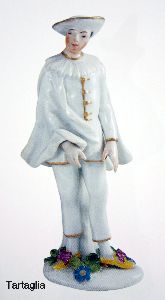 His costume is a flowing cloak and knee breeches. His costume is a flowing cloak and knee breeches.
Tartaglia. Model no.1600
This model is referred to as Pedrolino in the Meissen factory records.
Source: engraving by F.Joullain
Tartaglia is a dreamer who is short sighted and has a terrible stutter. He is a young personable and gullible servant who is both innocent and charming. His costume is a cloak over a jacket and ankle length trousers.
Pierrot. Model no. 1736
Source: Engraving by F.Joullain
Pierrot as a character is similar to Tartaglia. He is unworldly and full of melancholy. His stance with his hands raised, palms facing the audience, makes him look isolated and vulnerable. His costume consists of a loose fitting white jacket with a large buttons, and long baggy trousers and a wide brimmed hat, all predominantly white.
Mezzetin. Model no. 1721
Source: Engraving by F.Joullain
Mezzetin was a servant and a companion of Scapin's. He was a gifted musician an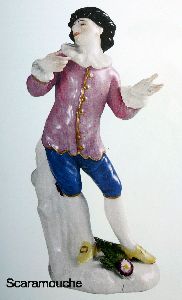 d dancer but unscrupulous and always ready to gamble and stir up trouble. d dancer but unscrupulous and always ready to gamble and stir up trouble.
Scaramouche. Model no. 592
This model is referred to as Mezzetin in the Meissen factory records
Source. Engraving after a lost painting by A.J.Watteau
Scaramouche. Model no.1725
Source: Not known
Scaramouche was a roguish adventurer from a humble background. He was fond of the bottle, intrigue and women, quick tempered and agile of foot. His costume was a black beret, black shirt and trousers.
Pantelone. Model no.541
Source: Based on an engraving by F.Joullain after J.Callot
Pantelone is a Venice merchant. He is always old, Sometimes a rich miser, sometimes a poor man. If he is rich he is a slave to his money. If he is married his wife is usually young and often deceiving him. He loves to give advice and is often the recipient of blows from his servant Harlequin's slapstick. His costume was a long sleeved black robe, red jacket and red breeches and stockings created together. On his feet he wore comfortable Turkish slippers.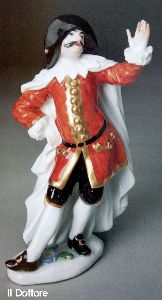
Il Dottore. Model no.544
Source: Engraving by F.Joullain
Il Dottore, sometimes known as Dottore Balanzone is the local aristocrat who was educated at the university of Bologna. He is extremely rich and enjoys good food and wine and is a friend of Pantelone. He is very self opinionated and is made fun of by his servant Harlequin. His costume reflects his academic qualifications, a large brimmed hat, a ruff around his neck, long jacket and knee breeches.
Pulcinella. Model no. 941
Source; Engraving by F. Joullain
Pulcinella is a hunchback originally from Naples who is a companion and rival of Scaramouche. A two faced character with a volcanic temper, he responds more often with his cudgel or his foot than with a clever exchange of words. His costume is a long baggy white blouse tied around the waist with a leather belt, baggy white trousers and a sugar loaf hat. He carries a cudg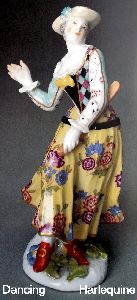 el. el.
Harlequine Dancing. Model no.455
Source: Not known
Harlequine the female equivalent of Harlequin was probably used to match couples during dances and because her costume, also for dramatic effect. Her costume was a close fitting sleeved waistcoat or skirted jacket with a full skirt. Diamond shapes of red, yellow, green and blue covered the whole costume. On her head she wore a small, jaunty hat with a small cockade or feather and she carried a slapstick.
Columbina. Model no. 1118
Source: Not known
Columbina was a maid servant who was rarely virtuous, had a lusty and promiscuous nature and was often involved in intrigue. Harlequin was her lover. Her costume was the simple one of a working woman. A bodice with a chemise underneath and a separate skirt covered with an apron.
So far I have concentrated solely on the eighteenth century but there was one other series of Commedia dell'arte figures modelled at Meissen. This series of twelve figures model numbered S 120- S 131, was not produced until 1902. it was bases on the illustrations by Maurice Sand (1823-1889) from his book Masks and Buffoons published in Paris in 1860. What is unusual about this series is that it was not created by one artist but by a collaboration of artists. Romanus Anderson modelled five of the figures while Konrad Hentschel,Alfred Koenig and Paul Helmig creat ed the r ed the r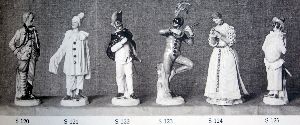 emainder. emainder.
None of the Commedia dell'arte figures are easy to acquire, whether they are from the early and expensive Duke of Weissenfels series , the nineteenth century adaptations of eighteenth century models or even the figures based on the illustrations of Maurice Sand. The collector who embarks on the acquisition of these wonderfully dramatic characters from a bygone age will have to be endowed not only with a great deal of patience but also with deep pockets.
Bibliography.
Meissen China an illustrated history by Dr.K Berling
Meissen Figures 1730-1755 The Kaendler Period by Yvonne Adams
Harlequin Unmasked by Meredith Chilton
Commedia dell’arte. Fest der Komödianten
|